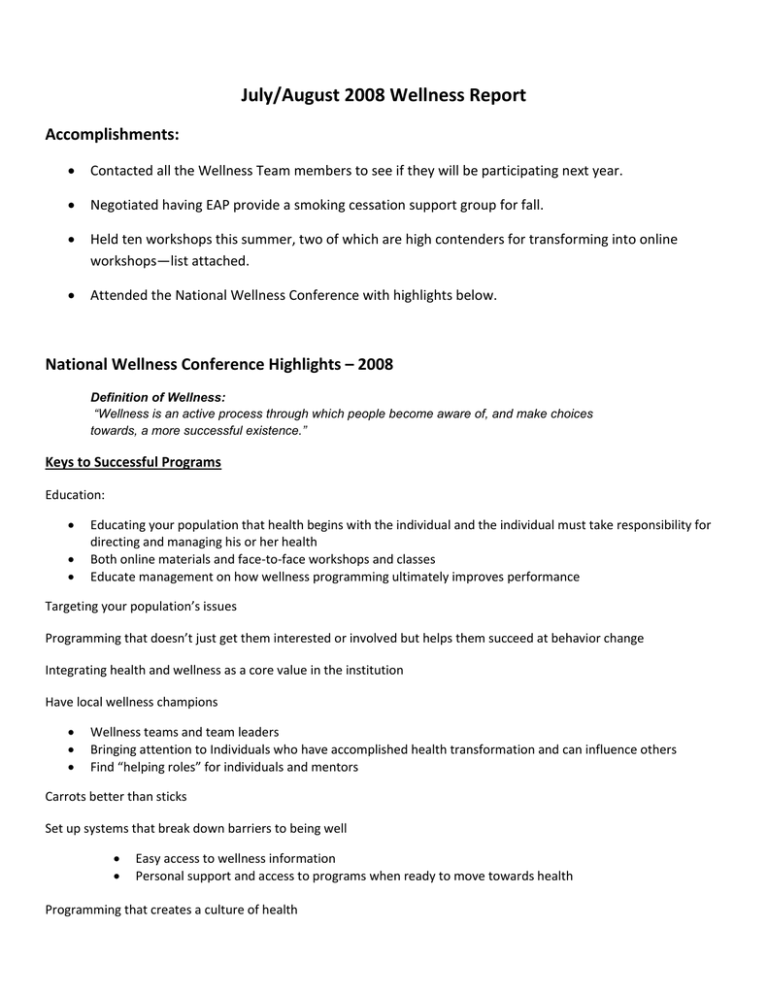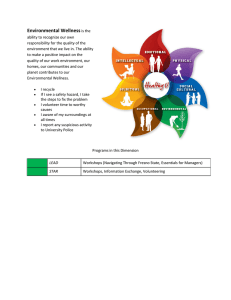July/August 2008 Wellness Report Accomplishments:
advertisement

July/August 2008 Wellness Report Accomplishments: Contacted all the Wellness Team members to see if they will be participating next year. Negotiated having EAP provide a smoking cessation support group for fall. Held ten workshops this summer, two of which are high contenders for transforming into online workshops—list attached. Attended the National Wellness Conference with highlights below. National Wellness Conference Highlights – 2008 Definition of Wellness: “Wellness is an active process through which people become aware of, and make choices towards, a more successful existence.” Keys to Successful Programs Education: Educating your population that health begins with the individual and the individual must take responsibility for directing and managing his or her health Both online materials and face-to-face workshops and classes Educate management on how wellness programming ultimately improves performance Targeting your population’s issues Programming that doesn’t just get them interested or involved but helps them succeed at behavior change Integrating health and wellness as a core value in the institution Have local wellness champions Wellness teams and team leaders Bringing attention to Individuals who have accomplished health transformation and can influence others Find “helping roles” for individuals and mentors Carrots better than sticks Set up systems that break down barriers to being well Easy access to wellness information Personal support and access to programs when ready to move towards health Programming that creates a culture of health What Research has Proven Doesn’t Work Total online programs Paying employees to change An absence of “wellness-trained” staff Bad timing when setting up a program; i.e. the institution is not ready to change Low to No Budget – (measurement of program success is essential which requires money) Lunch and Learns with no follow up systems that support true behavior change. * Focusing on “High-Risk” population only Health Behavior Change “To affect change in your organization you have to understand your population and how they’re stuck.” Long-lasting health behavior change is supported by: Determining True Readiness Analysis of pros and cons of change If they are ready Set start date Set specific goal: break down in small steps. Design a strategy Transfer skills from what worked before in their life Creating new skills and knowledge in area of change needed Have personal support tools in place: such as coaching, peer support, support groups, program Set up accountability systems Plan for how to cope with setbacks Have Rewards and Celebrations Suggestions for 2008-2009 Increase Online Materials-especially tutorials that transform behavior Vital Foods Cancer, Diabetes and Heart Disease Smoking Cessation Workshops Select our most effective presenters and workshops form last year and put them on the schedule Promotion Make wellness more visibly present within institution via posters; put up posters a month out for programming *Promote Blue Care Connection: poster, flyer and email campaign Target High-Risk groups: Stop Smoking workshop followed by Stop Smoking Support Group led by EAP Cancer and Diabetes workshops both online and face to face Collaborations/Accessing Resources Collaborate with Student Life and the City of Austin on sharing resources.

